Today is the 28th anniversary of the Waco Branch Davidian tragedy which some of my readers will vividly remember. David Koresh and his remaining 75 followers–a racially diverse group of men, women, and children–perished in a horrific fire at their Mt Carmel center outside Waco, Texas, under siege for 51 days by the FBI. What happened that day was totally unnecessary, as we know clearly know. The events of that Monday are burned in my memory, as I was closely involved, along with Dr. Philip Arnold, from start to finish, as part of a plan that might well have avoided these senseless deaths. At noon today there will be a private memorial, the names of the dead will be read and remembered. I will attend and address the group, as I have so many of these past 28 years–this year virtually via Zoom.
If you want to refresh your memory of the horrors of that day I included some of the major resources in a post last year called “Remembering Waco: A 2020 Vision of Things.” Pun intended. You can follow the links and delve as deeply as you wish or have time for. First and foremost I highly recommend Malcom Gladwell’s insightful 2014 New Yorker piece, Sacred and Profane: How Not to Negotiate with Believers
I also have posted this quick review: Waco After 25 Years: Getting the Facts Straight. For a gripping narrative account of the main events leading up to the tragic fire you can access the first chapter of my 1995 co-authored book, Why Waco free on-line here–just chose the option “Read an Excerpt” in the right sidebar. I encourage you to buy the book itself–it is available on Amazon here. The Paramount pictures 2018 miniseries “Waco,” available on various streaming services, starring Taylor Kitsch as Koresh and Michael Shannon as FBI agent Gary Noesner, is as gripping as it gets–and on the whole quite accurate. My character–supposedly a “composite” of me and Dr. Philip Arnold, (who looks nothing like either of us–then or now!) appears briefly in the final episodes.
Much has been written and produced on film about Waco in these intervening years–good, bad, and ugly. But slowly, the full story has emerged. I want to announce today the most comprehensive treatment of the subject to date. It is based on the collective experience and research of four of us who have spent the past two decades delving into every aspect of the Waco tragedy. We have interviewed the survivors, consulted with the FBI, and engaged with congressional hearings–in addition to collecting and surveying all available archive evidence on those critical days. At the end there is a segment with Koresh singing one of his compositions–“The Book of Daniel,” and a segment of him teaching, as well as a listing of all those who died and survived.
It is free and now uploaded to Youtube. The entire film interview is nearly three hours but it is broken into six segments below, so you can selective make use of it. The links and the detailed descriptions are below. I would say that in this extended interview we cover just about every aspect of the Waco story. If you watch it all you will be well informed. Some things we know, others we are not sure of–and the key question at the end is what have we learned? I make this available to you for the first time today. I hope it will be of help to all my readers, colleagues, and students, in “Remembering Waco” and what went so terribly wrong that day. For those who want to dig a bit deeper, I have also posted a two hour interview delving into the Davidian movement and its origins, long before Koresh was even born. [1]The full Waco story begins many years before David Koresh. For a treatment of that, from Davidian leader Dudley Goff, who was involved with the movement and its founder, Victor Houteff, in the 1950s, … Continue reading

The Waco Branch Davidian Tragedy: What Have We Learned or Not Learned?
I thank most of all Dr. Philip Arnold and the good folks at Reunion Institute for providing the funding for this production. This was a full studio production with multiple cameras and was professionally edited and tailored to our needs by Minji Lee. Arnold initiated the idea, invited the rest of us, and spent thousands of dollars to make this happen. Also, heartfelt appreciation to Dr. Catherine Wessinger who spent many hours breaking this up into logical segments, writing the annotations, and hosting it on her Youtube site. We are all so very grateful and hope this will serve our students and the public for a long time to come. So far as I know there is nothing out there like this–that honestly tries to survey and present all sides of a very messy and complex subject.
Entire film is 2:53:00. URL is: https://youtu.be/s5qw0WlB-aw
Scholars participating in the conversation:
J. Phillip Arnold, PhD, Reunion Institute
James D. Tabor, PhD, University of North Carolina at Charlotte
Catherine Wessinger, PhD, Loyola University New Orleans
Stuart A. Wright, PhD, Lamar University
Copyright: Reunion Institute, 2020
Film on Catherine Wessinger YouTube Channel
Sections of the Film
Prelude: 911 Calls (1:18 mins.) The Prelude of The Waco Branch Davidian Tragedy: What Have We Learned or Not Learned? consists of two 911 calls made by Branch Davidians on February 28, 1993, during and shortly after the attempted dynamic entry by ATF agents. Wayne Martin made one call, and David Koresh is heard on the other call.
Part 1. Introducing the Four Scholars & the Topic (20:57 mins.).
Part 1 of The Waco Branch Davidian Tragedy: What Have We Learned or Not Learned? introduces the four scholars who discuss the conflict between federal agents and the Branch Davidian in 1993.
The four scholars are:
J. Phillip Arnold, PhD, Reunion Institute
James D. Tabor, PhD, University of North Carolina at Charlotte
Catherine Wessinger, PhD, Loyola University New Orleans
Stuart A. Wright, PhD, Lamar University
The four scholars introduce themselves, their research methodologies, and how they became involved in researching the conflict between the Branch Davidians and federal agents in 1993. They also discuss the beginning of the siege at the Branch Davidans’ Mount Carmel Center on February 28, 1993 with the ATF raid.
Part 2. Introducing the Branch Davidians and David Koresh (10:59 mins.),
Part 2 of The Waco Branch Davidian Tragedy: What Have We Learned or Not Learned? the four scholars introduce the Branch Davidians, David Koresh, and discuss the ATF raid on February 28, 1993 that resulted in 4 ATF agents dead and 6 Branch Davidians dead, with others wounded.
Part 3. The First Day of the Siege (4:39 mins.).
In Part 3 of The Waco Branch Davidian Tragedy: What Have We Learned or Not Learned? the four scholars discuss why the ATF team selected February 28, 1993 to carry out an attempted dynamic entry at Mount Carmel Center, the role played by the Waco Tribune-Herald’s “The Sinful Messiah” series, and the nature of the child abuse allegations against David Koresh and that they had been investigated by Child Protective Services in 1992 and the case had been closed for lack of evidence.
Part 4. Who Are the Branch Davidians? (29:03 mins.).
In Part 4 of The Waco Branch Davidian Tragedy: What Have We Learned or Not Learned? the four scholars discuss the origins and history of the Branch Davidians, religious leaders and movements related to David Koresh’s group, Koresh’s teachings derived from the Bible, the meaning of his multiple marriages, the significance of Vernon Howell’s name change to David Koresh, what he taught concerning the Seven Seals in the book of Revelation and his status as the Christ for the Last Days. The four scholars emphasize that Koresh’s apocalyptic prophecies derived from his interpretation of the Bible were not fixed, meaning that the outcome of the conflict with federal agents in 1993 was not automatically predetermined by the Branch Davidians’ understanding of the Bible’s prophecies.
Part 5. FBI’s Involvement & Escalation (22:02 mins.).
In Part 5 of The Waco Branch Davidian Tragedy, the scholars discuss the FBI’s involvement and escalation of the events in the case. They discuss how angry the FBI agents were, especially the on-site commander and Hostage Rescue Team commander, when on March 2 David Koresh did not come out, as he had promised, after his taped sermon was played on television and radio. After Koresh told the FBI agents that God had told him to wait, tanks were driven onto the Mount Carmel property by FBI agents. Gary Noesner, the FBI agent who was negotiation coordinator from March 1 to March 24, subsequently wrote that he had expected that there would be set-backs in negotiations, but that was just the process involved in persuading more people to come out. The scholars discuss Koresh’s theological understanding of the events of the ATF assault and the siege in light of the Seven Seals of the book of Revelation, especially the Fifth Seal. They discuss how surveillance devices in the building picked up audio of Branch Davidians discussing dying in a fire after David Koresh had an argument with a negotiator on April 18, 1993. These discussions about fire were audible on the surveillance device audiotapes, so the FBI decision makers would have been aware of these conversations. Therefore, the scholars ask why FBI decision makers would have moved forward with the tank and gas assault on April 19, 1993 when they knew the Branch Davidians were expecting to die in a fire if they were attacked.
Dr. J. Phillip Arnold recounts how toward the end of March 1993 he received a tip from a reporter that FBI agents were preparing to take action against the Branch Davidians. He then asked what he and Dr. James D. Tabor could do to save lives. They had tried to speak with FBI agents, but they were not listening to the Bible scholars seeking to explain the theology to them.
Part 6. Role of Religious Studies (22:29 mins.).
In Part 6 of The Waco Branch Davidian Tragedy, the four scholars discuss the efforts made by Dr. J. Phillip Arnold and Dr. James D. Tabor to convey an alternative interpretation of the book of Revelation’s prophecies that would enable David Koresh to come out and be taken into custody and also lead the rest of the Branch Davidians out, and importantly, bring the children out. After Dr. Arnold received a tip that the FBI agents were planning an assault against the Branch Davidians’ residence, Drs. Arnold and Tabor arranged to discuss the book of Revelation on the Ron Engelman radio talk show out of Dallas on April 1, 1993. They suggested that David Koresh would be able to write his book about the prophecies even after being put in prison, and that way he could get his message out and save more souls. Subsequently, Koresh’s attorney Dick DeGuerin took the audiotape of their radio discussion inside the residence and sat with David Koresh and other Branch Davidians as they listened to the tape. David Koresh had promised that they would come out after the 7-day observance of Passover. Passover ended on April 13. On April 14, 1993, Koresh sent out a letter to the FBI saying that God had told him to write down his interpretation of the Seven Seals in the book of Revelation; after the manuscript was given to Drs. Arnold and Tabor for safekeeping, he would come out. Also, on April 14, Koresh sent out a signed contract to retain DeGuerin as his defense attorney.
FBI agents with the Hostage Rescue Team in the tanks/Combat Engineering Vehicles (CEVs) had been harassing the Branch Davidians, for instance by throwing flash-bang grenade at anyone who came outside, including one time when Steve Schneider had permission to come out and pick up something from an agent in a CEV. The harassment increased while Koresh was writing his manuscript. More people were flashbanged when they came outside. A CEV rammed the wall of the building on the very early morning of April 16, nearly injuring a man sleeping with his head toward that wall. Nevertheless, Koresh reported to a negotiator at 2:35 am on April 16 that he had completed composing his commentary on the First Seal.
Since the Branch Davidians had no electricity, they began requesting batteries and ribbon cassettes for a battery-operated word processor so Koresh’s chapter on the First Seal could be typed up and saved on a floppy disk. The Branch Davidians continued asking for the supplies for the word processor on April 17 and 18. The supplies were finally delivered to the Branch Davidians on the evening of April 18, the night before the tank and CS gas assault by FBI agents on April 19, 1993.
Branch Davidian Ruth Riddle stayed up all night typing Koresh’s commentary on the First Seal. When the fire started just after noon on April 19, 1993, after 6 hours of the building being gassed and dismantled by the CEVs, Ruth Riddle jumped out of a window of the burning building with the floppy disk in her pocket. Drs. Arnold and Tabor kept their promise to Koresh to make his commentary available to scholars, by distributing 500 copies at a session at the American Academy of Religion/Society of Biblical Literature conference in November 1993. Koresh’s commentary on the First Seal was published in a book titled Why Waco? Cults and the Battle for Religious Freedom in America by James D. Tabor and Eugene V. Gallagher (1995).
Catherine Wessinger points out that in documentaries retired FBI negotiator Byron Sage has said that if Koresh had just sent out evidence that he was writing his manuscript, the FBI would not have carried out the tank and CS gas assault on April 19, 1993. She points out the FBI held back the supplies that the Branch Davidians needed to type up a copy of Koresh’s commentary on the First Seal until the evening of April 18.
Part 7. Despite Efforts of Scholars, Tragedy Strikes (17:38 mins.).
In Part 7 of The Waco Branch Davidian Tragedy, the scholars discuss the FBI tank and CS gas assault on the Branch Davidians in their residence at Mount Carmel outside Waco, Texas on April 19, 1993. Combat Engineering Vehicles (CEVs) were used to spray CS gas into the building and to dismantle the building. Rocket-shaped plastic ferret rounds containing CS were fired into the building; they burst open and release gas upon impact. Some of the adults had gas masks. There were no child-sized gas masks. The mothers and their children, ages 13 and younger, and two pregnant women took shelter in a concrete room, a former vault that had the door removed from it; it had an open doorway with a cloth hanging down. The assault began at 6:00 am Central Time. The fire erupted at 12:07 pm Central Time.
Within 5 minutes after the assault began, the telephone line to the negotiators, which ran along the ground, was severed. FBI agents claimed that the telephone was thrown out the front door shortly after FBI negotiator Byron Sage called in at 6:00 am. Survivor Graeme Craddock has reported that phone was still located where it usually sat in the foyer; he said that even if the phone had been thrown outside, he could have connected another phone. During the assault Steve Schneider was in the foyer directing Pablo Cohen and Graeme Craddock to go outside to see if they could fix the telephone line. He said that they wanted to tell the FBI about the progress that had been made during the previous night in typing up the manuscript for Koresh’s commentary on the First Seal. Graeme Craddock went outside and held up the severed telephone line, and Byron Sage on a loudspeaker acknowledged that the agents could see that it was broken. Sage said that another “telephone” would be sent in, but it never was. Subsequently Graeme Craddock surmised that the telephone line was severed by a tank running over it at the beginning of the assault.
At 11:31 a.m. Central Time a CEV drove through the front of the building to spray gas through the doorway of the concrete room where the children and mothers were located. This area was gassed until 11:55 am. Dr. J. Phillip Arnold recalled that at the 1995 congressional hearing, the driver of the CEV stated that he could see the people inside the concrete room. The fire started at 12:07 pm on the second floor.
Graeme Craddock testified that he saw someone pouring fuel, but Pablo Cohen objected to it being poured inside the building. Craddock also stated that while on the first floor he heard a shout from the second floor to light the fire. Pablo Cohen shouted his objection. Another shout from the second floor said not to start the fire. Then a third shout from the second floor said to light the fire, as it was heard by Craddock. Army Col. Rodney Rawlings told reporter Lee Hancock in 1999 that he and FBI agents heard a similar sequence of shouts on the audio captured by surveillance devices. An audiotape containing such audio picked up by a surveillance device has never been produced by the FBI.
Dr. J. Phillip Arnold argues that there were biblical reasons for lighting a fire to protect the people of God. However the fire started and for what purpose, the gassing of the children and mothers was the key turning point in the assault. Dr. Stuart Wright points out that CS gas comes with a warning that it is not to be used in enclosed spaces. Dr. Catherine Wessinger reports on New York Police Department personnel who testified before a congressional committee that the NYPD would never use CS gas on barricaded subjects that include children. Children have small lung capacity so they are less able to withstand the effects of the gas. CS gas and the methylene chloride liquid base in which it was conveyed are both flammable.
Dr. Stuart Wright points out that apostate exaggerations to the ATF agents probably resulted in the excessively armed approach of the ATF agents in the attempted dynamic entry on February 28, 1993.
Part 8. How Can We Understand the New Religious Groups Better? (13:07 mins.).
In Part 8 of The Waco Branch Davidian Tragedy: What Have We Learned or Not Learned? the four scholars discuss how the scholarly study of new religious movements sheds light on the conflict between the Branch Davidians and federal agents in 1993 as well as on other controversial new religious movements. They point out that “cult essentialism” is a point of view that puts all the blame on the “cult leader” and the followers if violence occurs and people are injured and killed. “Cult essentialism” conveyed by the pejorative word “cult” obscures that such incidents usually occur within interactive contexts. The scholars discuss other new religious movements that were controversial in similar ways in their respective time and place, including the early Christian movement. Sociologist Dr. James T. Richardson’s articulation of the “myth of the omnipotent leader” is described and it is pointed out that the ATF and FBI agents believed that David Koresh had total power over the followers, when that was not the case. The “myth of the omnipotent leader” corresponds with what Richardson has termed the “myth of the passive, brainwashed follower,” which is a perspective that downplays the follower’s agency in deciding what they believe and whether or not to stay with a group. It is pointed out that the American Psychological Association concluded that the “brainwashing thesis” has no factual basis and is pseudoscientific. The scholars also discuss that New Testament scholar Dr. Eugene V. Gallagher has pointed out that apocalyptic believers always interpret their scripture in light of the context, in light of things that are happening around them and to them. So once the siege of the Branch Davidians began on February 28, 1993, it was not a foregone conclusion about how the siege would end. If the FBI had reduced the tactical aggression against the Branch Davidians and not sabotaged the negotiations with the Branch Davidians, the deaths of 76 people including children on April 19, 1993 could have been avoided.
Part 9. FBI Missed Opportunity (31:28 mins.).
In Part 9 of The Waco Branch Davidian Tragedy: What Have We Learned or Not Learned? the four scholars discuss what the FBI profilers/behavioral scientists and the FBI decision makers knew about the Branch Davidian apocalyptic theology of martyrdom. How could the FBI agents have utilized the Branch Davidians’ theological ultimate concern to resolve the siege without loss of life? The scholars believe that the only way to have resolved the siege peacefully was to take into account the Branch Davidians’ theology and ultimate concern. It was important that the FBI agents not precipitate the fulfillment of the prophecies as Koresh had articulated them.
Dr. J. Phillip Arnold points out that in mid-March he was on the radio discussing the Seven Seals of the book of Revelation. Some of the Branch Davidians heard him on the radio, and Steve Schneider, Koresh’s righthand man, asked a negotiator to let Dr. Arnold discuss the Seals with Koresh. Schneider said that if Dr. Arnold could show from the Bible’s prophecies that the Branch Davidians should come out, they would come out. The FBI agents never let Dr. Arnold have a discussion with Koresh or anyone inside the residence. This was an untried option.
Dr. Catherine Wessinger points out that not only were the FBI decision makers not listening to Dr. Arnold, but they were not listening to their own profilers/behavioral scientists.
Some of the negotiators made the mistake of measuring Koresh’s theology against their own Christian beliefs and then decided he was not really preaching something that he believed in. Other FBI agents saw Koresh as a con man who did not believe the theology he was teaching.
After the 76 deaths at the Branch Davidians’ Mount Carmel on April 19, 1993 resulting from the tank and CS gas assault by the FBI, changes were made in the structure of the FBI entity that would address future “critical incidents.” A Critical Incident Response Group (CIRG) was created to give the views of the FBI negotiators equal weight with the commander of the Hostage Rescue Team; both teams report to the CIRG commander during a critical incident so the efforts of the two teams can be coordinated, instead of the Hostage Rescue Team working against the negotiations. This approach was tested successfully with the standoff with the Montana Freemen in 1996.
Dr. Stuart A. Wright states that a number of the documentaries aired in 2018 about the Branch Davidian case rely on the simplistic cult stereotype. Some highlight the salacious aspects of the community instead of focusing on the interactions of federal agents with the Branch Davidians. Four of six documentaries that he reviewed in a 2019 Nova Religio article did not include the views of a single scholar. Dr. James Tabor states that he and Dr. Arnold were interviewed extensively for two of the television network documentaries, but their interviews were not included.
Dr. Arnold points out that the Branch Davidians believed they had a future when they would return in power and glory. They would have seen their martyrdom as a translation into the heavenly realm. During the siege, the Branch Davidians were “waiting on God.” They were waiting to see what God had in store for them.
The scholars discuss how the Branch Davidian community may have developed if the ATF raid had never occurred on February 28, 1993, which precipitated the FBI siege and final assault on April 19, 1993. David Koresh may have become a successful performer with his band. He articulated his theological interpretations in his songs. Dr. Arnold imagines that David Koresh and his band may have performed in the 1994 Woodstock festival.
The film ends with David Koresh performing his song “Book of Daniel.” The credits include a list of the number of men, women, and children who died in the assaults on February 28, 1993 and April 19, 1993, and the number of those who survived the fire. All of the names of those who died and survived and their ages are given. The final footage shows David Koresh giving a Bible study to his students.
Epilogue: David Koresh Performing “Book of Daniel” and Teaching His Bible Students – Names of Branch Davidians in 1993 (6:13 mins.).
The Waco Branch Davidian Tragedy: What Have We Learned or Not Learned? ends with David Koresh performing his song “Book of Daniel.” The credits include a list of the number of men, women, and children who died in the assaults on February 28, 1993 and April 19, 1993, and the number of those who survived the fire. All of the names of those who died and survived and their ages are given. The final footage shows David Koresh giving a Bible study to his students.


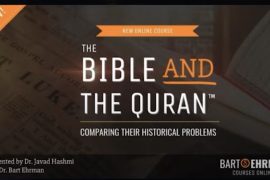
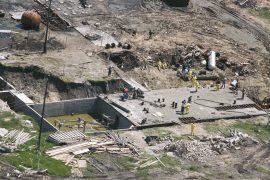
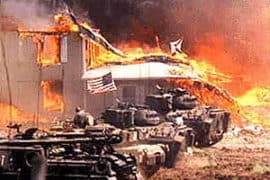
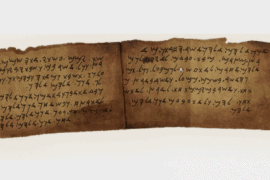
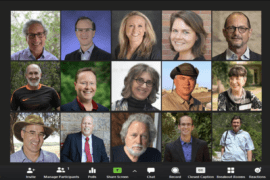
Comments are closed.